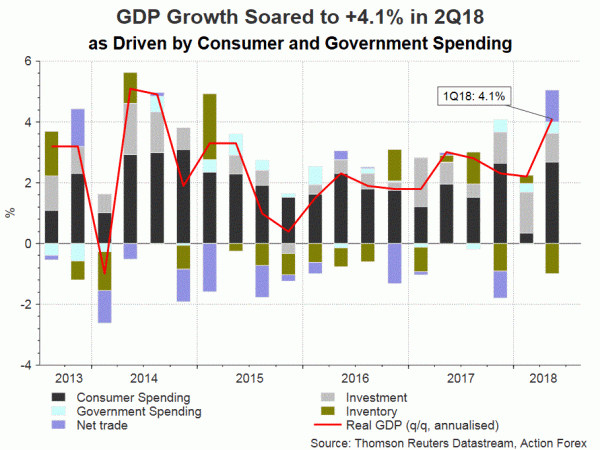The upcoming FOMC meeting later this week aims at preparing the market for another +25 bps rate hike in September. As no press conference and economic projections would follow the August meeting, the post-meeting statement, and the minutes three weeks in three weeks, would be used for communication and setting expectations. We expect the rhetoric of the upcoming statement/minutes would be more or less the same as the June one, at which some members suggested to “modify the language in the post-meeting statement”. Against the backdrop of robust GDP growth, inflation and employment on one hand, and heightening US-China trade conflict on another, the members would likely have rigorous debate over the future path on rate hike. After all, we expect the rate hike path would remain unchanged from the one lain down in June (100 bps increases in both 2018 and 2019). The debate on the change in the “forward guidance” which had been indicating that “the stance of monetary policy remains accommodative” would continue this month with actual change could come later in the year.
The first estimate of US GDP growth soared to an annualized +4.1% q/q in 2Q18, thanks to the strength in private consumption (+4%) and government spending (+3.5%). Business investment grew +5.4%, moderating from +8% in the first quarter, while net exports improved. The strong outcome was a result of fiscal stimulus and strong household spending evidenced the underlying momentum of the domestic economy. However, contribution from net exports could have been driven by temporary factors, including the normalization of auto sales and front-loaded soybean exports to China, which might dissipate in the second half of the year. There will be two revisions to 2Q18 GDP growth data and they could show dramatic change to the preliminary result. Headline inflation improved further to +2.9% y/y in June, from +2.8% a month ago. Core CPI also accelerated to +2.3%, the largest rise since January 2017, from +2.2% in May. PCE, Fed’s preferred inflation estimate, would likely stay around the +2% target in June. The economic backdrop hence warrants the Fed to retain its language that growth has been “solid” and household spending “has picked up”.
Unemployment rate edged higher to 4% in June, from 3.9% in May. The market anticipates it to return to 3.9% in July. Since the FOMC meeting takes place ahead of the release of the June employment report, the member might thus need to adjust the language slightly to illustrate the increase in the unemployment rate in May. The Fed might need to restore the description that unemployment rate has stayed “low” (used in the May statement), after noting that the unemployment rate has “declined” in the June statement.
The June minutes revealed that the members discussed the term structure of interest rates. We expect the discussions would continue in August given the fact the Treasury yield curve has flattened by a greater extent since the June meeting.


 Signal2forex.com - Best Forex robots and signals
Signal2forex.com - Best Forex robots and signals




